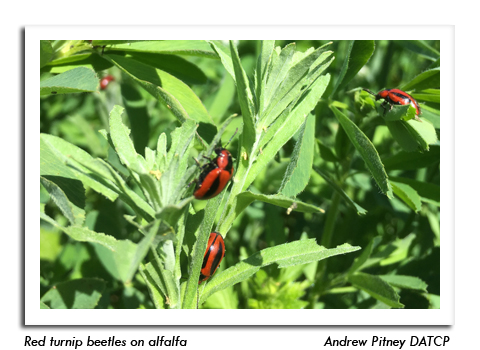
 |
|
|
Vegetables
Volume 63 Number 8 Date 06/21/2018 ZEBRA CATERPILLAR - This infrequent pest with prominent black and yellow longitudinal stripes was defoliating kohlrabi leaves at a La Crosse County CSA on June 15. Larvae feed during the day on the foliage of a variety of broadleaf field and vegetable crops, ornamental trees and flowers, causing ragged leaves. The young caterpillars initially feed together in groups, but later separate and feed individually. The zebra caterpillar occurs sporadically in Wisconsin and is generally not considered a serious pest. Manual removal of the larvae is the preferred form of control. SQUASH VINE BORER - Moths were observed around squash and cucumbers in Dane County over the weekend of June 16-17. Their mid-June appearance signals for vegetable growers to begin checking vine crops for the flat, brown eggs deposited at the base of stems. Control is required immediately after the eggs are found to prevent the larvae from boring into the vines. Gardeners may remove the eggs by scraping them off with a fingernail. Covering plants with row covers or netting to prevent egg deposition and placing yellow pheromone-baited sticky traps around plantings may also help to reduce SVB problems. A conventional insecticide or kaolin clay applied to the plant bases as a weekly spray during the three- or four-week egg laying period can provide protection if the sprays thoroughly cover the plant stems and are applied repeatedly to assure good control. IMPORTED CABBAGEWORM - Damage caused by larger cabbageworms has become very conspicuous, making the velvety green caterpillars generally easy to find and remove from gardens and smaller plantings. For larger commercial cabbage crops where chemical control may be required, ICW populations should be assessed weekly by examining 25-50 randomly-selected plants (depending on field size) and recording the number of infested plants. A plant is infested if eggs or caterpillars are found. Control decisions should be made based on a threshold of 30% infestation in the transplant to cupping stages; 20% infestation from the cupping to early head stages; and 10% from early heading until harvest. For broccoli and cauliflower between transplant and first flower or curd, the threshold is 50%, decreasing to 10% once flowers or curds begin to develop to maintain quality. POTATO LEAFHOPPER - Development and reproduction has increased with intermittent June heat. Counts thus far have not justified treatment, but numbers are approaching the economic threshold of 1.0 per sweep in 8-11 inch alfalfa and 2.0 per sweep in alfalfa taller than 12 inches. This observation suggests populations are likewise increasing in vegetable hosts such as snap beans and potatoes. A threshold of one nymph per 10 leaves or one adult per sweep indicates control is justified for snap beans. The threshold for potatoes is 2.5 nymphs per 25 leaves or 0.5-1.0 adult per sweep. RED TURNIP BEETLE - This red and black beetle has been observed in Waushara County alfalfa in the past two weeks. Red turnip beetle is a sporadic pest in the Central Sands area of the state, feeding on plants in the mustard family. Hosts include broccoli, cabbage, kohlrabi, radish and turnip, but hoary alyssum and yellow rocket are thought to be the primary food plants. Small seedlings and transplants are the most susceptible to red turnip beetle feeding, while established plants can tolerate severe defoliation. Removing the adult beetles by hand is the recommended control. Beetle numbers usually begin to decline by early July. -- Krista Hamilton, DATCP Entomologist 





|
|
|